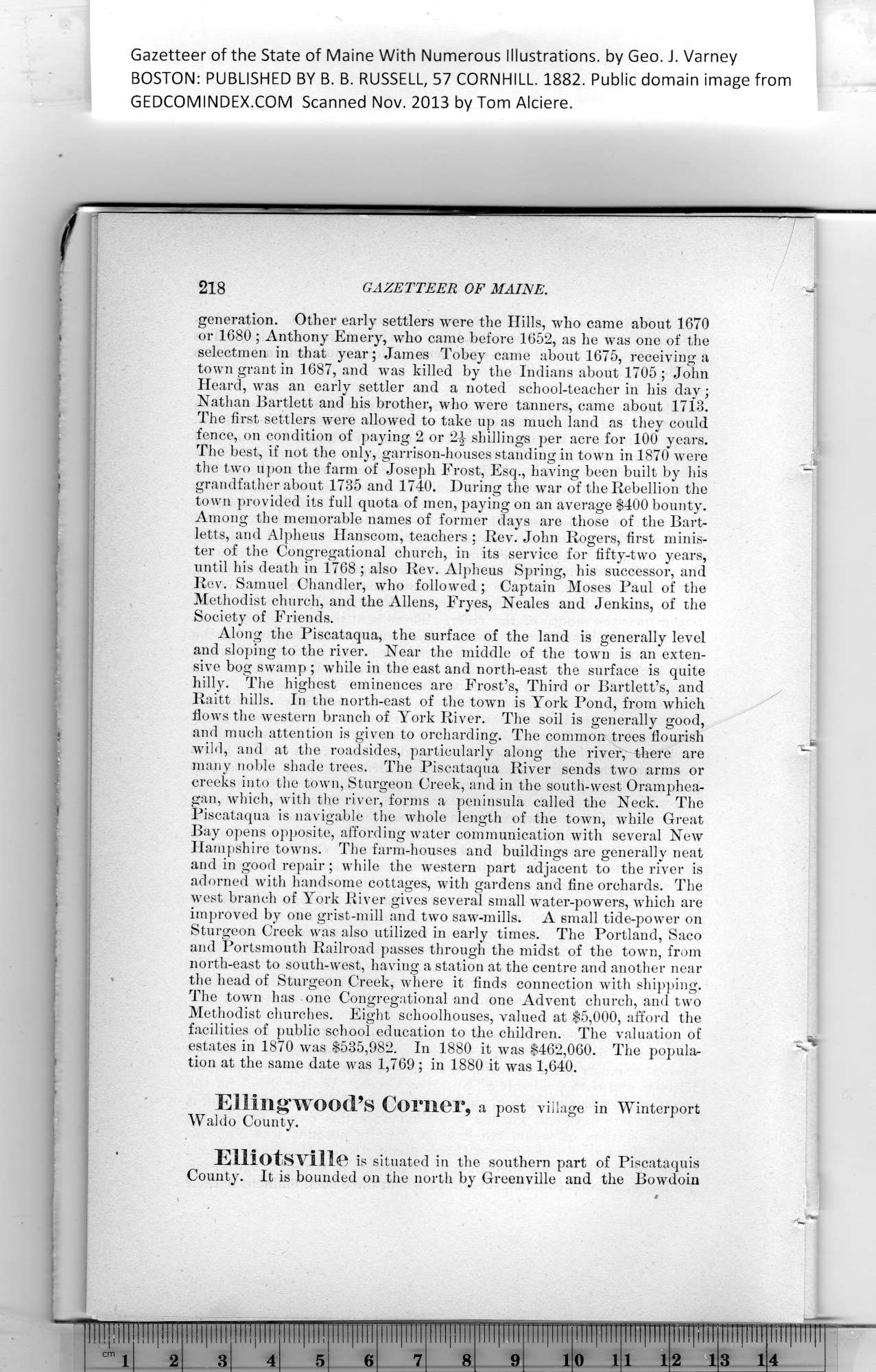|
Gazetteer of the State of Maine With Numerous Illustrations, by Geo. J. Varney
BOSTON: PUBLISHED BY B. B. RUSSELL, 57 CORNHILL. 1882. Public domain image from
218 GAZETTEER OF MAINE.
generation. Other early settlers were the Hills, who came about 1670
or 1680 ; Anthony Emery, who came before 1652, as he was one of the
selectmen in that year; James Tobey came about 1675, receiving a
town grant in 1687, and was killed by the Indians about 1705; John
Heard, was an early settler and a noted school-teacher in his day;
Nathan Bartlett and his brother, who were tanners, came about 1718.
The first settlers were allowed to take up as much land as they could
fence, on condition of paying 2 or 2-J- shillings per acre for 100 years.
The best, if not the only, garrison-houses standing in town in 1870 were
the two upon the farm of Joseph Frost, Esq., having been built by his
grandfather about 1785 and 1740. During the war of the Rebellion the
town provided its full quota of men, paying on an average $400 bounty.
Among the memorable names of former days are those of the Bart-
letts, and Alpheus Hanscom, teachers : Rev. John Rogers, first minis-
ter of the Congregational church, in its service for fifty-two years,
until his death in 1768 ; also Rev. Alpheus Spring, his successor, and
Rev. Samuel Chandler, who followed; Captain Moses Paul of the
Methodist church, and the Allens, Fryes, Neales and Jenkins, of the
Society of Friends.
Along the Piscataqua, the surface of the land is generally level
and sloping to the river. Near the middle of the town is an exten-
sive bog swamp ; while in the east and north-east the surface is quite
hilly. The highest eminences are Frost’s, Third or Bartlett’s, aud
Raitt hills. In the north-east of the town is York Pond, from which
flows the western branch of York River. The soil is generally good,
and much attention is given to orcharding. The common trees flourish^
wild, and at the roadsides, particularly along the river, there are
many noble shade trees. The Piscataqua River sends two arms or
creeks into the town, Sturgeon Creek, and in the south-west Oramphea-
gan, which, with the river, forms a peninsula called the Neck. The
Piscataqua is navigable the whole length of the town, while Great
Bay opens opposite, affording water communication with several New
Hampshire towns. The farm-houses and buildings are generally neat
and in good repair; while the western part adjacent to the river is
adorned with handsome cottages, wdth gardens and fine orchards. The
west branch of York River gives several small water-powers, which are
improved by one grist-mill and two saw-mills. A small tide-power on
Sturgeon Creek was also utilized in early times. The Portland, Saco
and Portsmouth Railroad passes through the midst of the town, from
north-east to south-west, having a station at the centre and another near
the head of Sturgeon Creek, where it finds connection with shipping.
The town has one Congregational and one Advent church, and two
Methodist churches. Eight schoolhouses, valued at $5,000, afford the
facilities of public school education to the children. The valuation of
estates in 1870 was $535,982. In 1880 it was $462,060. The popula-
tion at the same date was 1,769; in 1880 it was 1,640.
Ellingwood’s Corner, a post village in Winterport
Waldo County.
Elliotsville is situated in the southern part of Piscataquis
County. It is bounded on the north by Greenville and the Bowdoin
PREVIOUS PAGE ... NEXT PAGE
This page was written in HTML using a program written in Python 3.2
|
